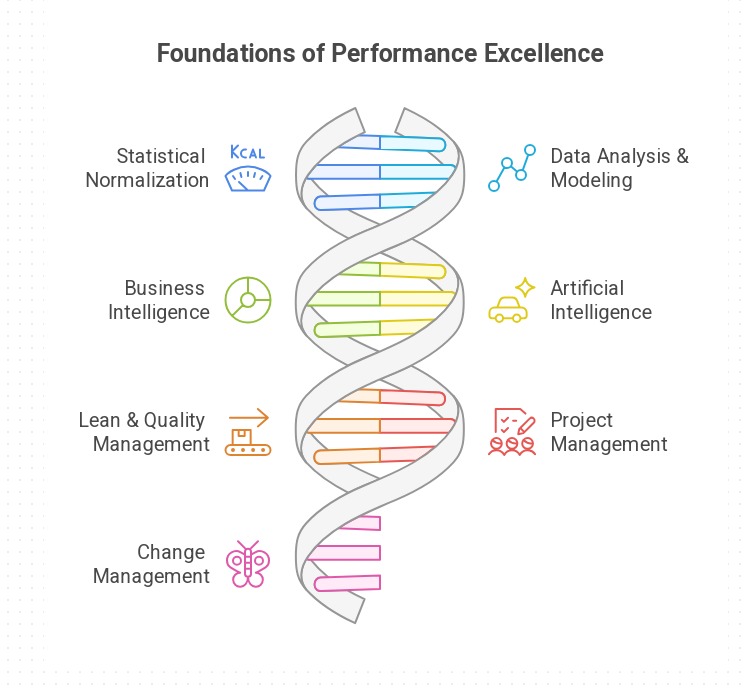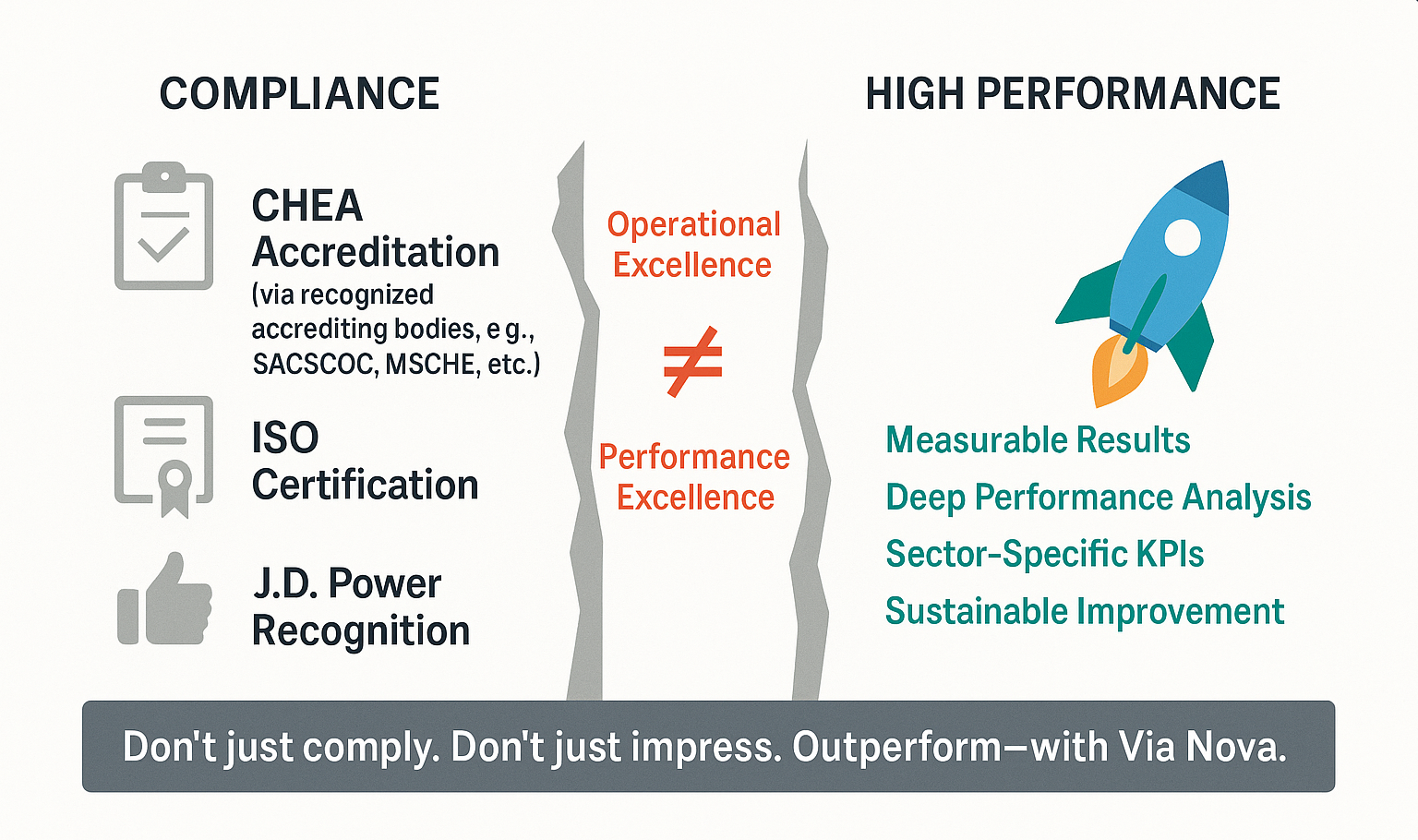Via Nova
Home > Via Nova
What is Via Nova?
Via Nova is a pragmatic management framework designed to drive institutional performance through cycles of Agile, prioritized mini-projects.
What sets Via Nova apart is its unique integration of proven tools and techniques within a single, cohesive framework. These include:
- Decision-Making Tools: Structured questionnaires, focus groups, and other methods to gather insights and guide informed choices.
- SMART objectives: Using SMART objectives ensures that every improvement effort is purposeful, trackable, and results-oriented.

Specific: Clearly defined and focused on a particular outcome.
Measurable: Quantifiable, so progress can be tracked.
Achievable: Realistic and attainable given available resources.
Relevant: Aligned with broader organizational priorities.
Time-bound: Set within a defined timeframe for completion.
- Statistical Normalization and Composite Indexing: Prioritizing standards objectively to ensure resources are focused where they matter most.
- Data Analysis & Modeling: Leveraging advanced analytics to formulate robust data models that inform strategy.
- Business Intelligence: Extracting actionable data from operational systems to support evidence-based decisions.
- Artificial Intelligence: Generating and discovering high-impact projects and initiatives to accelerate performance improvement.
- Lean & Quality Management/Quality Control: Streamlining processes, eliminating waste, and ensuring consistent quality across operations.
- Project Management: Applying both Agile/Scrum and traditional methodologies to ensure efficient execution and adaptability.
- Change Management: Upgrading operations, processes, people, and technology to embed lasting improvements.
Key Differentiators:
- Via Nova is not just about recognition—it’s about real, measurable performance gains.
- Every step is structured and pragmatic, ensuring improvements are sustainable and directly tied to business outcomes.
- Via Nova’s methodology is adaptable to any sector and is always grounded in data and results, not just perception.


Why Settle for “Operational Excellence” When You Can Achieve True Performance Excellence?
- At Via Nova, we believe that compliance, recognition, or simply “running well” is not enough. Whether you’re a higher education institution, manufacturer, or healthcare provider, your mission demands more than just checking boxes or earning badges. It demands measurable, sustainable, and high-impact results.
- Via Nova goes deeper. We measure what truly matters: effectiveness, efficiency, and real-world outcomes. Unlike traditional accreditation (CHEA), ISO certification, or even J.D. Power recognition—which often focus on processes, paperwork, or perception— Our structured, pragmatic approach uses sector-specific KPIs to expose gaps, drive improvement, and deliver results that are visible, actionable, and lasting.
- Every organization—profit or non-profit—should feel the urgency to perform at the highest level. Via Nova is designed to ignite that drive—transforming “good enough” into “exceptional,” and turning operational routines into engines of high performance.
Via Nova

Quality Certifications
Purpose and Focus
Via Nova
A pragmatic management framework designed to drive real, measurable improvements in institutional performance. It focuses on cycles of mini-projects prioritized by impact, with progress tracked against key metrics that matter most to the organization.
Quality Certifications
Primarily focused on ensuring that an organization’s processes meet established international standards for quality, safety, or efficiency. The emphasis is on compliance with documented procedures and passing external audits.
Approach
Via Nova
Action-oriented and flexible. It uses data analysis, business intelligence, and AI to identify high-impact projects, then applies project management and change management to deliver results. The framework adapts to the institution’s unique needs and continuously measures progress.
Quality Certifications
Process-driven and prescriptive. Organizations must document, standardize, and consistently follow specific procedures. The goal is to maintain conformity and demonstrate this through regular audits.
Tangible Benefits
Via Nova
Directly targets and improves the key metrics that drive institutional success—such as financial performance, operational efficiency, student outcomes, or patient care—depending on the sector. Every initiative is selected and measured for its real-world impact.
Quality Certifications
Benefits are often indirect, such as improved consistency, reduced errors, and enhanced reputation. While these can lead to better performance, the primary outcome is certification itself, not necessarily measurable gains in core institutional metrics.
Customization and Adaptability
Via Nova
Highly customizable. The framework is tailored to the institution’s goals, challenges, and context. It evolves as needs change and as new data emerges.
Quality Certifications
Standardized. The requirements are largely the same for all organizations within a sector, with limited room for adaptation beyond what the standard allows.
Mindset and Culture
Via Nova
Promotes a culture of continuous improvement, innovation, and accountability. Success is defined by tangible progress and value creation, not just adherence to rules.
Quality Certifications
Encourages a culture of compliance and risk management, with success measured by conformity to standards and successful audits.
Via Nova is not just about meeting standards—it’s about moving the needle on the metrics that matter most to your institution. While ISO and similar certifications ensure you’re doing things right, Via Nova ensures you’re doing the right things to achieve real, sustainable performance gains.
Via Nova

Higher Education Accreditations
Core Objective
Via Nova
Focuses on driving tangible, measurable improvements in institutional performance. The framework is designed to deliver real value by targeting key metrics that directly impact outcomes—such as financial health, operational efficiency, student achievement, or patient care.
Higher Education Accreditations
Primarily ensures that institutions meet established minimum standards set by external bodies. The main goal is to demonstrate conformity and maintain eligibility for recognition, funding, or legal operation.
Approach
Via Nova
Proactive and dynamic. Uses data analysis, business intelligence, and AI to identify and prioritize high-impact projects. Emphasizes continuous improvement through cycles of mini-projects, each measured for progress and results.
Higher Education Accreditations
Reactive and checklist-driven. Institutions follow prescribed processes and document evidence to satisfy external reviewers or auditors. The focus is on passing periodic evaluations rather than ongoing improvement.
Customization
Via Nova
Highly adaptable to the unique context, goals, and challenges of each institution. The framework evolves as priorities shift and new data emerges.
Higher Education Accreditations
Largely standardized. Requirements are set by accrediting or regulatory bodies and apply broadly, with limited flexibility for local adaptation.
Measurement of Success
Via Nova
Success is defined by measurable progress on the institution’s most important metrics. Every initiative is selected for its potential to create real, lasting value.
Higher Education Accreditations
Success is defined by achieving or maintaining accredited status or compliance certification, regardless of whether this leads to meaningful performance gains.
Mindset and Culture
Via Nova
Fosters a culture of innovation, accountability, and continuous improvement. Encourages teams to seek out and implement changes that drive results.
Higher Education Accreditations
Reinforces a culture of risk avoidance and rule-following. The emphasis is on not falling short of standards, rather than striving for excellence.
Via Nova goes beyond simply meeting external requirements. It empowers institutions to achieve real, sustainable progress by focusing on what truly matters for their success. While traditional compliance ensures you meet the minimum bar, Via Nova helps you raise it—delivering measurable improvements that benefit your institution and its stakeholders.
Via Nova

J.D. Power Certification
| Aspect | Via Nova | J.D. Power Certification |
| Core Focus | Performance improvement, measurable results, and operational effectiveness & efficiency | Customer and employee satisfaction, service quality, and experience |
| Approach | Structured, pragmatic, and data-driven methodology; focuses on KPIs, process optimization, and tangible outcomes | Benchmarking against industry best practices, customer/employee surveys, and operational audits |
| Measurement | Uses sector-specific KPIs (manufacturing, healthcare, HE, etc.) to track real performance and progress | Relies on satisfaction surveys and compliance with best practices |
| Scope | Holistic: covers all operational areas (efficiency, quality, cost, delivery, etc.) | Typically focused on customer-facing operations, claims, or employee development |
| Outcome | Directly improves effectiveness and efficiency; delivers actionable insights and sustainable change | Recognizes organizations for high satisfaction; provides a marketing advantage |
| Customization | Tailored to each organization’s needs, sector, and maturity; adaptable and scalable | Follows J.D. Power’s proprietary benchmarks and criteria for each program |
| Recognition | Demonstrates operational excellence through measurable improvements and results | Certification badge for marketing and public trust |
| Pragmatism | Action-oriented, with a focus on real-world impact and continuous improvement | Recognition-oriented, with a focus on perception and experience |
Who Should Adopt Via Nova?
Via Nova is designed for organizations—both for-profit and non-profit—in Higher Education, Manufacturing, and Healthcare that are facing operational or financial challenges. If your institution is experiencing declining performance, financial distress, or resource constraints, Via Nova can help you turn things around.


You may benefit from Via Nova if your organization faces
- Consistent decline in key metrics (enrollment, profit, satisfaction)
- Negative or declining operating margins
- High debt ratios or insufficient cash reserves
- Operational inefficiencies (low utilization, high defect/error rates)
- Regulatory or compliance risks
- High staff turnover or low retention
- Performance is as expected, but the organization wants to do better.
Our Approach
Via Nova provides a comprehensive framework to:
- Diagnose root causes of underperformance
- Implement targeted, data-driven interventions
- Restore sustainable growth and operational excellence

Early Warnings to Take Action
The following tables highlight just a sample of key indicators whose values may signal the need for immediate action. There are many other potential red flags unique to each organization—many of which can be uncovered through Via Nova’s Discovery process

Proven, data-driven methodology

Tailored solutions for your industry

Focus on sustainable, long-term results

Support for both for-profit and non-profit organizations
Higher Education
| Indicator | Description | At-Risk Threshold |
| Enrollment Decline | Year-over-year % drop in student enrollment | >5% decrease |
| Graduation Rate | % of students graduating within expected time | <50% |
| Retention Rate | % of first-year students returning next year | <70% |
| Operating Margin | Net income as % of revenue | Negative or declining |
| Endowment per Student | Endowment funds divided by total enrollment | Below peer average |
| Debt Service Ratio | % of budget for debt repayment | >10% |
| Credit Rating (Moody’s/S&P) | Institutional creditworthiness | Below investment grade (Ba1/BB+) |
| Student Loan Default Rate | % of students defaulting on loans | >10% |
Manufacturing
| Indicator | Description | At-Risk Threshold |
| Profit Margin | Net profit as % of revenue | <5% |
| Capacity Utilization | % of production capacity used | <70% |
| Defect Rate | % of products with defects | >2% |
| Inventory Turnover | Number of inventory cycles per year | <4x |
| Debt-to-Equity Ratio | Total debt divided by equity | >2.0 |
| Return on Assets (ROA) | Net income as % of total assets | <3% |
| OSHA Incidents | Workplace safety incidents per year | Above industry average |
| Order Lead Time | Avg. time from order to delivery | Increasing or above norm |
Healthcare
| Indicator | Description | At-Risk Threshold |
| Operating Margin | Net income as % of revenue | <2% or negative |
| Readmission Rate | % of patients readmitted within 30 days | >15% |
| Patient Satisfaction | HCAHPS top-box score | <70% |
| Avg. Length of Stay | Days per patient admission | Above peer average |
| Staff Turnover Rate | % of staff leaving annually | >20% |
| Occupancy Rate | % of beds occupied | <60% |
| Days Cash on Hand | Days the organization can operate with cash | <30 days |
| Bad Debt/Charity Care | % of revenue lost to bad debt/charity | >5% |
Note: Via Nova can help institutions select, customize, and track KPIs based on their unique challenges and goals, ensuring that every improvement initiative is tied to metrics that truly matter for institutional survival and long-term success.
Ready to See What’s Possible?
Discover how IC Commerce and Consulting, with Via Nova as our flagship, can help your organization—no matter the industry—achieve what others think is impossible.

